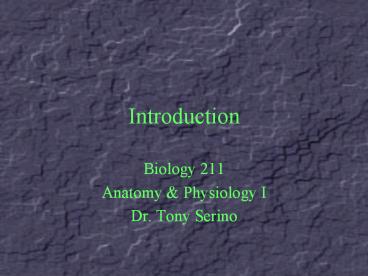Biology 211 - PowerPoint PPT Presentation
1 / 24
Title:
Biology 211
Description:
... Body Plan Tube within a tube Bilateral Symmetry Dorsal Hollow Nerve cord Notochord and vertebra Segmentation Pharnygeal gill slits Body Planes Anatomical ... – PowerPoint PPT presentation
Number of Views:49
Avg rating:3.0/5.0
Title: Biology 211
1
Introduction
- Biology 211
- Anatomy Physiology I
- Dr. Tony Serino
2
Anatomy Physiology
- Anatomy study of body structures and their
relationships - Physiology study of body mechanisms (homeostasis)
3
Levels of Anatomy
4
Body Plan
skin
- Tube within a tube
- Bilateral Symmetry
- Dorsal Hollow Nerve cord
- Notochord and vertebra
- Segmentation
- Pharnygeal gill slits
gut
5
Internal vs. External Environment
6
Body Cavities
(Peritoneal cavity)
7
Serous Membranes Mesenteries
- Mesothelium (simple squamous epithelium) lining
the body cavities (parietal) and their organs
(visceral) - Each membrane is named for the cavity it lines
- Form double membranes which suspend organs within
cavities - True mesenteries connect the body wall to the
organ - Ligaments connect organ to organ
8
Visceral vs. Parietal
Parietal membrane
Body Cavity filled with serous fluid
Visceral membrane
9
Pericardium
10
Pleura
Parietal Pleura
Visceral Pleura
Pleural cavity
11
Peritoneum
Peritonealcavity (includes abdominaland pelvic
cavities)
Parietal Peritoneum
Visceral Peritoneum
12
Abdominal Regions
13
Abdominal Quadrants
14
Body Plan
Body Planes
- Tube within a tube
- Bilateral Symmetry
- Dorsal Hollow Nerve cord
- Notochord and vertebra
- Segmentation
- Pharnygeal gill slits
15
Anatomical Directions
16
(No Transcript)
17
(No Transcript)
18
Body Plan
- Tube within a tube
- Bilateral Symmetry
- Dorsal Hollow Nerve cord
- Notochord and vertebra
- Segmentation
- Pharnygeal gill slits
19
Body Plan
- Tube within a tube
- Bilateral Symmetry
- Dorsal Hollow Nerve cord
- Notochord and vertebra
- Segmentation
- Pharnygeal gill slits
20
Body Plan
- Tube within a tube
- Bilateral Symmetry
- Dorsal Hollow Nerve cord
- Notochord and vertebra
- Segmentation
- Pharnygeal gill slits
21
Homeostasis
- Maintenance of a constant internal environment
- Uses a reflex arc to self regulate
- Reflex functions to maintain a certain set point
with a narrow physiological range
22
Factors Affecting Homeostasis
- Feedback negative or positive
- Feed-forward regulation
- Acclimatization
- Biorhythms
23
Body Fluids
Transcellular fluids are filtrates of the plasma
24
Important Ions































